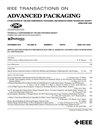Hierarchical Finite-Element Reduction-Recovery Method for Large-Scale Transient Analysis of High-Speed Integrated Circuits
引用次数: 10
Abstract
This paper proposes a hierarchical finite-element reduction-recovery method for large-scale transient analysis of high-speed integrated circuits. This method rigorously reduces the matrix of a multilayer system of O(N) to that of a single-cell system of O(1) regardless of the original problem size. More important, the matrix reduction is achieved analytically, and hence the CPU and memory overheads are minimal. In addition, the reduction preserves the sparsity of the original system matrix. As a result, the matrix factorization cost is reduced to O(1) by the proposed method. The CPU cost at each time step scales linearly with the number of unknowns. The method is applicable to any Manhattan-type integrated circuit embedded in layered dielectric media. Numerical and experimental results demonstrate the performance of the proposed method.高速集成电路大规模暂态分析的层次有限元还原法
提出了一种用于高速集成电路大规模暂态分析的分层有限元还原方法。该方法将O(N)多层系统的矩阵严格化简为O(1)单细胞系统的矩阵,而不考虑原始问题的大小。更重要的是,矩阵减少是通过分析实现的,因此CPU和内存开销最小。此外,这种约简保留了原始系统矩阵的稀疏性。结果表明,该方法将矩阵分解成本降低到0(1)。每个时间步长的CPU成本与未知数的数量呈线性关系。该方法适用于任何嵌入在层状介质中的曼哈顿型集成电路。数值和实验结果验证了该方法的有效性。
本文章由计算机程序翻译,如有差异,请以英文原文为准。
求助全文
约1分钟内获得全文
求助全文

 求助内容:
求助内容: 应助结果提醒方式:
应助结果提醒方式:


